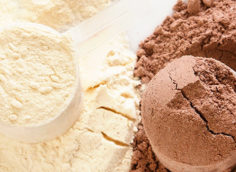Any group of athletes that train as hard as the members of the T-Nation ultimately must confront the near-inevitability of overtraining. And although it may seem passé to some, the question surrounding the cause of overtraining does come up. Why does overtraining occur? Why can some of us continue on with a brutal training regime (without falling apart) longer than others?
These questions have been looked at closely by a growing group of researchers. Their efforts have determined some very good ways to quantify and track training load versus recovery. In fact, I've used these methods myself with remarkable results; heck, even historically reluctant professional sports teams are now listening. Why? Because it's logical.
You see, when using an accountant's spreadsheet as an analogy, it can be seen that–however it gets quantified–the "balance" must come out better-than-or-equal-to zero. That is, intense frequent training must be met with at least an equal amount of purposeful recovery. Surely massage, hot-and-cold contrast showers, meditation, adequate sleep, social support, stretching, power naps, and other methods can "put back" some of that expended energy.
But ultimately and justifiably, the "recovery balance sheet" centers on nutrition.
It's been suggested that nutritional support is fully half of the recuperative picture.(10) Similar to patients in clinical settings, the timely provision of carbohydrates, proteins, and sometimes various micronutrients (vitamins, minerals, phytochemicals, even specialty supplements) are acutely critical. Macronutrient nutrition is certainly a key recovery topic that we've all come to appreciate. There's little need to further expound the virtues of high glycemic carbohydrates and fast acting (whey) proteins during the few hours following exercise. One could even kick it up a notch by emphasizing diluted carbohydrates (and possibly proteins) during exercise to bolster performance and actually reduce training stress.(20) This improves the overall recovery balance sheet even further.
And let's not forget adequate hydration. It's necessary to counter or exceed one's typical weight loss (and plasma volume decline) during an exercise bout; perhaps a half to one liter depending on climate, etc. This suggestion isn't just lip service. Did you know that simply drinking 600 ml water during dehydrating (hot) exercise can reduce the catecholamine stress response?(19) That could make a difference to a near-overtrained athlete.
Rehydration also maintains skin blood flow during exercise (2), a factor which itself seems to increase subcutaneous fat loss.(6,23) So let's see... less stress and improved fat loss... yeah, I think I'll be carrying that water bottle or sports drink to the gym from now on.
And we have yet to consider dietary fats! Although just as important as proteins and carbs, healthy fats are less specific to acute post-workout recovery. A primary reason is that they don't just enter a muscle cell, they become part of its very membrane. For such reasons they're generally considered longer-acting, chronic support nutrients. (See Something's Fishy for just how crucial they are.
All these lines of thinking continue to beg the question: is overtraining really just under-eating?
I almost wish it were so. But let's put this hopeful question to bed once and for all. There are a number of biological factors that require time to return to normal (or indeed, supra-normal) status. Despite the insistence of various bodybuilding gurus from years' past, we can't aggressively eat our way into immediate recovery. In fact, "Fortress" and I discuss this at length in our recent CD / DVD release. Let's look at a pseudo case study as an example:
Justin Case has been lifting and doing "cardio" six days per week for the past two months. Since he's a big believer in the "overtraining is merely under-eating" concept, he's been consuming 5000 kcal daily at a body weight of 170 pounds. Last week Justin began a heavy eccentric phase of training (concentrating on slow, lowering movements in the 90-120% of 1 RM range). He plans to do this with the help of a training partner for the next month, keeping up his six-day-per-week schedule.
Now for some hard questions: Where do you think Justin is heading? What specifically is going to happen and why? And perhaps most pertinent: Could YOU eat your way out of this scenario?
Biologically, there are several things going on in such a body. Muscle tissue is disrupted, initiating an injury response similar to elective surgery (13,14); the immune system reacts in its fairly general way, raising interleukins and elevating white blood cell counts;(4) the central nervous system (CNS) is stimulated so frequently that a hyper-adrenergic state (7) interferes with sleep patterns and ability to relax; and of course, glycogen stores can get depleted.
The nutritional implications of these perturbed systems are as follows: disrupted muscle tissue and subsequent growth factor release call for additional protein above maintenance needs for "compensatory hypertrophy" (e.g. 1.6-2.0 grams daily); a chronically elevated white cell count may also demand up to 30 grams of protein per day (18), although much of this may come from other bodily reserves (Ugh!); CNS stimulation coupled with cytokine release from the immune system initiate a hyper-metabolic state calling for an 11-24% greater kcal intake (3,13,14), and depleted glycogen and even intramuscular triacylglycerol (fat) reserves require additional dietary carbs and fats to replenish.
All this sounds like we can indeed simply hammer-back huge amounts of food and quickly fix our self-induced damage. But when seen in its full biological context, we clue in to necessary time frames for these nutrients to actually get used by the body....
First, eccentric muscle damage lasts for a period of at least four to five days based upon available data.(4) Its repair is not simply a matter of providing more building blocks. What about your "brick layers" (i.e. your immune and endocrine systems)? Are they willing to pull some major overtime? Considering their limited capacities and other duties, what do you think will happen to all those extra "bricks" (nutrients) you consume? I mean, doesn't it make sense that a limited number of bricklayers can only work so fast? And what's more, perceivable soreness can't be our only guide that the construction continues. It just doesn't always correlate with other damage markers.(21) Thus, the sorest individuals aren't always the ones who are most damaged or are re-growing best.
So does this leave brutal trainers totally in the dark when assessing recovery or planning their programs? Fortunately, no. We can turn to the lab geeks for help. (Ahem.) During the peak time of muscle trauma–based upon elevated circulating enzymes, white cell counts, weakness, metabolic elevations, edema (swelling) and microscope evaluations – they tell us that we are indeed limited by our biological repair and transport systems. These systems include nutrient digestion and absorption, blood flow (most of a resting capillary bed is closed at rest [8]), and the transit time of white cells to be drawn to areas of muscle damage.
That's right; we're not just waiting on nutrient delivery or androgens. This white blood cell "chemotactic response" takes time... time for synthesizing and flushing white cells from their point of origin; time for them to traverse other tissues and find those open capillaries (only 5% of our blood is in the capillaries at any given time); time for them to squeeze through blood vessel walls (that's "diapedesis through post-capillary venules" for you fellow science nerds); and time to reach and embed in muscle tissue. Check out Muscle Masochism for more on this.
You can see that exercise immunology is an important and mostly unaddressed frontier of muscle growth. Since those white cells are partly responsible for secretion of growth factors, a massive bolus of protein or calories at a premature or isolated point in time won't help much (with the partial exception of post-workout nutrition). Rather, a realistic and consistent intake makes more biological sense.
So we've seen that we have biological and temporal limits regarding bodybuilding recovery. Limitless eating does little for a limited body. Although nutrition is critical, patience is also a virtue when one sits down to plan his training/ eating regime. Stay tuned for Part II when we'll fire through several more reasons for following consistency and persistency, even more so than gross amounts of food.
References/ Additional Reading
1. Borel, M., et al. Estimation of energy expenditure and maintenance energy requirements of college-age men and women. Am J Clin Nutr 1984; 40(6):1264-72.
2. Coyle, E., and S. J. Montain. Thermal and cardiovascular responses to fluid replacement during exercise. In: Perspectives in Exercise Science and Sports Medicine. Exercise, Heat, and Thermoregulation, edited by C. V. Gisolfi, D. R. Lamb, and E. R. Nadel. Dubuque, IA: Brown, 1993, vol. 6, p. 179-224.
3. Dolezal, B., et al. Muscle damage and resting metabolic rate after acute resistance exercise with an eccentric overload. Med Sci Sports Exerc 32 (7): 1202-1207, 2000.
4. Evans, W. and Cannon, J. The metabolic effects of exercise-induced muscle damage. Exerc Sport Sci Rev. 1991; 19: 99-125.
5. Fowles, J., et al. The effects of acute passive stretch on muscle protein synthesis in humans. Can J Appl Physiol. 2000 Jun; 25(3): 165-80.
6. Frayn K., Regulation of fatty acid delivery in vivo. Adv Exp Med Biol. 1998; 441: 171-9.
7. Fry, A., et al. Catecholamine responses to short-term high-intensity resistance exercise overtraining. J Appl Physiol. 1994 Aug; 77(2): 941-6.
8. Ganong, W. Review of Medical Physiology, 15th Ed. Norwalk, Connecticut; Appleton and Lange: 546.
9. Jung, F., et al. Effect of Ginkgo biloba on fluidity of blood and peripheral microcirculation in volunteers. Arzneimittelforschung 1990 May;40(5):589-93.
10. Kentta, G. and Hassmen, P. Underrecovery and overtraining: A conceptual model. In: M. Kellmann (Ed.) Enhancing Recovery. Champaign, IL: Human Kinetics; 55-79.
11. Kraemer, W., et al. Detraining produces minimal changes in physical performance and hormonal variables in recreationally strength-trained men. J Strength Cond Res. 2002 Aug; 16(3): 373-82.
12. Ljungqvist, O. and Soreide, E. Preoperative fasting. Br J Surg. 2003 Apr; 90(4): 400-6.
13. Lowery, L. Nutritional support of athletic recovery and overtraining. Accepted for presentation. Tutorial to be presented at the annual conference of the American Society of Exercise Physiologists, Indianapolis, Indiana, USA. 2004.
14. Lowery, L. and Mendel, R. Measuring Muscle Recovery. Sports Cardiovascular and Wellness Nutritionists (SCAN) Annual Meeting, Chicago, Illinois, USA. 2003.
15. MacDougall, D., et al. The time course for elevated muscle protein synthesis following heavy resistance exercise. Can J Appl Physiol. 1995 Dec; 20(4): 480-6.
16. Martinez-Riquelme, A. and Allison, S. Insulin revisited. Clin Nutr. 2003 Feb; 22(1): 7-15.
17. McKenna, D., et al. Efficacy, safety, and use of ginkgo biloba in clinical and preclinical applications. Altern Ther Health Med 2001 Sep-Oct;7(5):70-86, 88-90.
18. Moldawer, L. Tutorial presented at the American Dietetic Association annual meeting, 1995.
19. Melin, B., et al. Effects of hydration state on hormonal and renal responses during moderate exercise in the heat. Eur J Appl Physiol Occup Physiol. 1997; 76(4): 320-7.
20. Nieman DC, Influence of mode and carbohydrate on the cytokine response to heavy exertion. Med Sci Sports Exerc May;30(5):671-678, 1998.
21. Priti, R., Miracle, A. and Lowery, L. Immunological responses are related to biochemical stress markers in the acute phase following damaging exercise. Ohio J Sci (Med Biol) 102(1): A7.
22. Sexton, T. and Lowery, L. Effects of eccentric exercise on glucose kinetics and insulin concentrations in resistance-trained athletes. Oh J Sci (Medicine and Biology) 2001; 101(1)(abstr): 13.
23. van der Merwe M., et al. Lactate and glycerol release from subcutaneous adipose tissue in black and white lean men. J Clin Endocrinol Metab. 1999 Aug; 84(8): 2888-95.
24. Widrick, J., et al. Time course of glycogen accumulation after eccentric exercise. J Appl Physiol 1992 May; 72(5):1999-2004.




